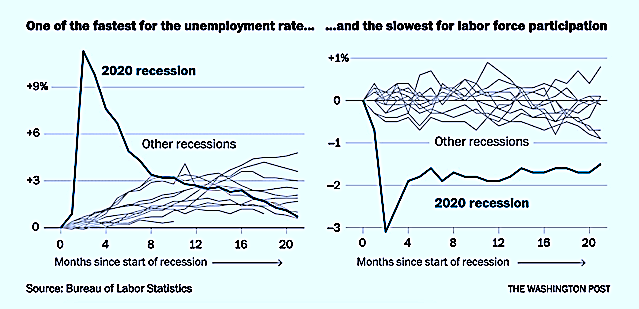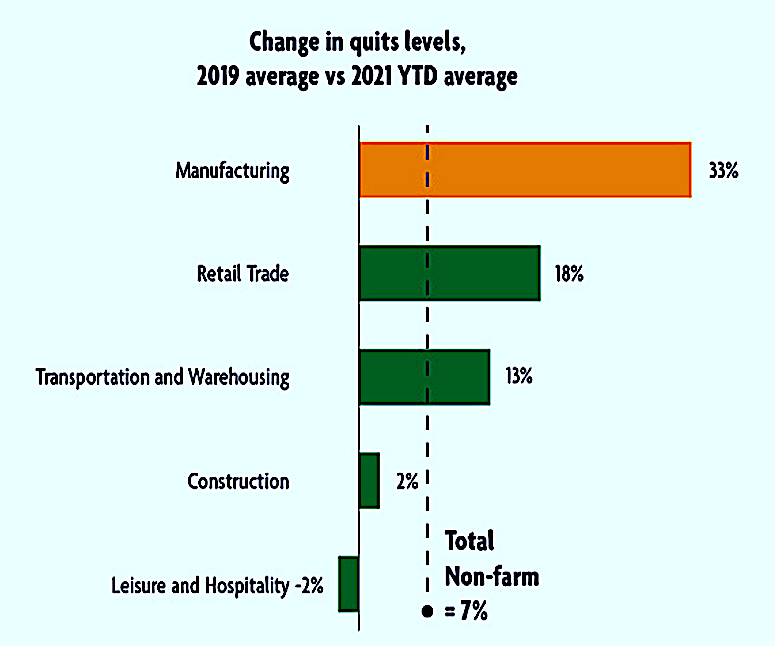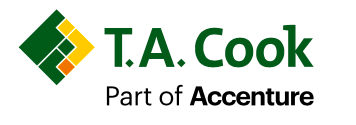From Chris Monson
Reliability and Maintenance Expert
T.A. Cook
Part of Accenture
(tacook.com)
We’re facing one of the most unusual job markets in recent history. The COVID-19 pandemic resulted in job losses on a nearly unprecedented scale, with 21 million newly unemployed in the U.S. in April 2020 alone, and a peak unemployment rate of 14.8%.
Yet, while some sectors have seen their employment rates return to near pre-pandemic levels, manufacturing is falling behind, facing an industry-leading quit rate and struggling to attract new talent. Indeed, in August 2021, the manufacturing sector posted 892,000 new jobs but was only able to fill 31,000 net positions, a deficit that may take years to recover from. So what can manufacturing organizations do to retain a skilled workforce, attract new talent, and build operational resiliency in this challenging climate? T.A. Cook’s Chris Monson provides details below.
The last two years has been a period of enormous uncertainty for all employers, with a 10% drop in employment followed by a once-in-a-generation economic recovery. This miraculous recovery only tells half the story, however. Despite a huge demand for workers, the percentage of people working or actively looking for work (the labor force participation rate) has barely moved. Although younger people have bolstered the number of job seekers, millions of workers in their 40s and up have retired or simply chosen not to return to work.
This enormous asymmetry between demand for workers and those wanting to work has been a boon for remaining job seekers, with higher wages and a huge variety of opportunities in the job market. Workers’ expectations have also changed, with many wanting more flexibility, technological integration, and more meaningful and engaging work. All of this has created enormous challenges and potential opportunities for employers looking to hire and retain talented employees.

Turning to the manufacturing sector, we see that the situation is particularly acute, with a hiring rate that has fallen further behind its competitors for the last two years. Although the hiring rate is slowly climbing, it has been accompanied by an astonishing quit rate – nearly double that of comparable sectors such as retail and transportation. Manufacturing faces increased competition from other sectors, particularly tech; yet at the same time it has been slower than its peers to increase wages and benefits. This explains part of the problem.
The fact remains, as manufacturing is losing its older, highly experienced workers to retirement and other causes, it is also failing to attract the young job seekers it needs to keep output at current levels, let alone grow. Automation and digitalization will play a role to mitigate this shortfall by increasing worker efficiency, but there is still much that a manufacturing organization can do to brace itself against both short-term shocks like COVID-19 and long-term structural trends. Namely, manufacturers should take measures to retain and maximize the output of the talent they do have, formalize existing expertise, and ensure a robust hiring pipeline for new talent.

The first of these strategies requires manufacturing managers to look at how they are treating their existing labor force and ask themselves, “Are my people being incentivized to stay?” Fair treatment, potential for growth, and flexible working options are the three pillars of this inquiry. Employees generally value fair pay and fair treatment above other factors when assessing job satisfaction. Improvements in technology have made manufacturing environments more sophisticated and more specialized. Wages should increase commensurate with higher skill requirements.
Next, identify development opportunities for your team. A process-technology-operator qualification and a Certified Maintenance and Reliability Technician (CMRT) certification are examples of how you can invest more in—and get greater return from —your workforce. Establish an internal apprenticeship program to provide opportunities for internal growth for less experienced workers who might otherwise seek growth elsewhere.
Then identify retraining opportunities for those who may still want to contribute to the organization but have expressed dissatisfaction with their current role. Planners, lube technicians, and storeroom clerks are all ideal positions for highly knowledgeable employees who may no longer wish to be “on the tools” in the maintenance team. Similarly, production operators can be retrained in process improvement, safety, or training roles. Many of those roles would also be ideal as part-time/semi-retirement positions for those who would still like to contribute but would otherwise be considering full retirement. Capturing and formalizing the institutional knowledge of more experienced workers also protects your organization from brain drain, as we will discuss next.
The second strategy involves implementing a well-devised, documented, and consistently applied set of operational procedures that will make your organization more resilient to worker turnover. A culture of tacit knowledge, weak systems, and information silos that relies too heavily on the experience of a relative few will not build the type of resilience that organizations need in today’s rapidly changing market. Not only will this approach make your organization more robust, but it will make your existing operation more efficient and more effective.
The first step is to develop a skills matrix to highlight those areas most vulnerable to employee turnover— the most critical skills possessed by the fewest workers. Identify these reservoirs of experience and systematize them.Do you have a 30-year lube-tech veteran who knows his or her role inside and out but has kept minimal records? Use his or her knowledge as the starting point for a formal set of lube rounds. Have one shift that can perform a product changeover 30% faster than the other shifts? Document their process and create a formal procedure to train the other shifts.
In addition, investing in automation systems and digitalization makes your operation more standardized, more repeatable, and less dependent on informal knowledge. Finally consider implementing a risk-based, FMEA reliability-centered maintenance program that can allow you to identify those maintenance activities which provide the best preventative “bang for your buck,” if you do find yourself in a labor deficit and needing to triage maintenance work to meet Overall Equipment Efficiency (OEE) targets.
The final strategy for building long-term workforce resiliency in your organization is to create a pipeline of talented people in your community who see manufacturing as a viable career. Managers must regard these talent-acquisition activities as a key part of their succession planning and cannot simply delegate this work to the Human Resources Department. resources. Establishing relationships with local high schools, technical colleges, and universities is an excellent place to start. Providing hands-on industry experience while being able to vet potential future candidates is a clear win-win. Utilizing co-op students can also be an excellent way to introduce some talented people into your organization and complete some valuable small projects. In my experience, people overestimate the effort and underestimate the value of this approach.
Perception also matters: Modern industrial plants are not the back-breaking, largely mindless workplaces of old, with many sites now having high levels of automation, digitization, and advanced analytics. This message needs to reach the younger, tech-savvy job seekers who might otherwise be lured to ostensibly greener pastures. It is also important to create a workplace culture of shared learning and mutual respect where team members across different generations are valued for their contributions. Millennials and Gen-Zs also expect more corporate social responsibility leadership from their employers, so bolstering your environmental performance and social engagement can help attract younger workers.
In conclusion, a once-in-a-generation public health crisis has created a labor shortage for a manufacturing sector already facing headwinds from rising wages, increased competition from the retail and tech sectors, and perception problems among younger workers. The best organizations will weather the storm by focusing on their people, creating a culture and operational systems that retain great talent and building a reputation to attract more.♦ ♦ ♦
CLICK HERE FOR MORE INFORMATION




